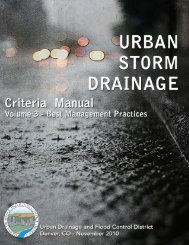BMP Monitoring Sites - Urban Drainage and Flood Control District
BMP Monitoring Sites - Urban Drainage and Flood Control District
BMP Monitoring Sites - Urban Drainage and Flood Control District
You also want an ePaper? Increase the reach of your titles
YUMPU automatically turns print PDFs into web optimized ePapers that Google loves.
UDFCD <strong>BMP</strong> MONITORING SITES<br />
Permeable Interlocking Concrete Pavement<br />
gravel <strong>and</strong> C-33 s<strong>and</strong>. In a trench beneath the s<strong>and</strong>, a perforated<br />
pipe collects the filtered water <strong>and</strong> conveys it to a catch basin.<br />
There is an orifice plate at the end of the pipe where a pressure<br />
transducer measures the flow into the catch basin from the PICP.<br />
There is also a weir plate at the outlet of the catch basin with a<br />
levelogger that measures the flow leaving the catch basin. The difference<br />
between the flow passing the orifice plate <strong>and</strong> the flow passing the weir<br />
plate is equal to the runoff that bypassed the PICP <strong>and</strong> entered the<br />
catch basin through the grate.<br />
The sampling equipment is stored in a metal box in the isl<strong>and</strong> adjacent<br />
to the PICP. A rain gage on a post near the storage box measures<br />
rainfall <strong>and</strong> signals the ISCO sampler inside the box to begin sampling<br />
after 0.1 inches of rain falls. The sampler then draws a sample of water<br />
from the PICP runoff after a designated flow has passed, <strong>and</strong> then<br />
every 15 minutes until 12 hours after the storm has ended.<br />
There is also a control watershed located a few hundred feet northeast of the<br />
PICP watershed. The control watershed consists primarily of traditional asphalt<br />
pavement <strong>and</strong> is used to compare results of treated runoff to untreated, direct<br />
runoff. Stormwater runoff from the control watershed is collected in a grated<br />
catch basin located in the northeast corner of the parking lot. The water leaves<br />
the catch basin by passing through a weir plate where a pressure transducer<br />
measures the flow. The sampling equipment is stored<br />
in a metal box adjacent to the parking lot in a manner<br />
similar to the PICP sampling configuration.
















